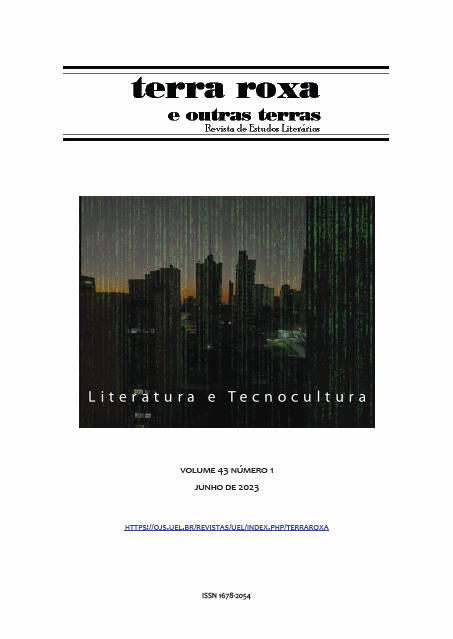Technocultural changes in the act of reading: theme and horizon in Kentucky Route Zero
DOI:
https://doi.org/10.5433/1678-2054.2023vol43n1p55Keywords:
Aesthetic response theory, Game studies, Videogames, Kentucky Route ZeroAbstract
This research paper explores the aesthetic response of players towards videogames, drawing from the theoretical framework of literary theory. It offers an analysis of the game Kentucky Route Zero (Cardboard Computer, 2020) as an exemplar. Adopting an interdisciplinary approach, we integrate Wolfgang Iser's (1996, 1999) response theory into the field of game studies. Our central objective is to address the following question: How do players engage in the process of meaning-production within a medium that actively invites their direct intervention in the materialization of the artwork through their agency? Informed by Murray (2003) and Juul (2019), we propose an adaptation of Iser's response theory to the realm of videogames. Subsequently, we test the applicability of this framework through a detailed analysis of a specific game. The findings suggest the emergence of a novel technocultural configuration of reception and interpretation. Firstly, the player's choices actively shape the textual materiality of the game. Secondly, even decisions not made by the player are integrated into the thematic and structural fabric of the artwork. Such unmade choices hold significance in the meaning-production process, comparable to the decisions that are effectively chosen by the player.
Downloads
References
AARSETH, Espen. Cybertext: perspectives on ergodic literature. Baltimore: The Johns Hopkins University, 1997. DOI: https://doi.org/10.56021/9780801855788
BARTHES, Roland. S/Z. Lisboa: Edições 70, 1999.
CARDBOARD COMPUTER. Kentucky Route Zero: TV Edition. [S. l.]: Annapurna Interactive, 2020a. videogame.
CARDBOARD COMPUTER. Kentucky Route Zero. [S. l.]: Cardboard Computer, 2020b. Disponível em: http://kentuckyroutezero.com/.
ESKELINEN, Markku. The gaming situation. Game Studies, v. 1, n. 1, 2001. Disponível em: http://www.gamestudies.org/0101/eskelinen/.
FASSONE, Riccardo. Every game is an island: endings and extremities in video games. New York: Bloomsbury, 2018.
FRASCA, Gonzalo. Videogames of the oppressed: videogames as a means for critical thinking and debate. Dissertação (Mestrado em Information Design and Technology) – School of Literature, Communication and Culture, Georgia Institute of Technology. Athens, 2001.
ISER, Wolfgang. O ato da leitura: uma teoria do efeito estético. v. 1. Trad. Johannes Kretschmer. São Paulo: 34, 1996.
ISER, Wolfgang. O ato da leitura: uma teoria do efeito estético. v. 2. Trad, Johannes Kretschmer. São Paulo: 34, 1999.
JUUL, Jesper. Half-real: videogames entre regras reais e mundos ficcionais. Trad. Alan Richard da Luz. São Paulo: Blucher, 2019.
LANDOW, George P. Hypertext: the convergence of contemporary critical theory and technology. Baltimore: The Johns Hopkins University, 1992.
MURRAY, Janet. Hamlet no holodeck: o futuro da narrativa no ciberespaço. Trad. Elissa Khoury Daher e Marcelo Fernandez Cuzziol. São Paulo: Itaú Cultural, 2003.
SALEN, Katie & Eric Zimmerman. Rules of play: game design fundamentals. Cambridge: MIT Press, 2004.
Downloads
Published
How to Cite
Issue
Section
License
Copyright (c) 2023 Natalia Corbello, Liliam Cristina Marins

This work is licensed under a Creative Commons Attribution 4.0 International License.
Authors who publish in this journal agree to the following terms:
a) The authors retain the copyright and grant the journal the right of first publication, the work being simultaneously licensed under the Creative Commons Attribution-NonCommercial 4.0 International License, allowing the sharing of the work with acknowledgment of the authorship of the work and initial publication in this journal.
b) Authors are authorized to assume additional contracts separately, for non-exclusive distribution of the version of the work published in this journal (eg, publish in an institutional repository or as a book chapter), with acknowledgment of authorship and initial publication in this journal.
c) Authors are allowed and encouraged to publish and distribute their work online (e.g. in institutional repositories or on their personal page) after the editorial process, as this can generate productive changes as well as increase impact and citation of the published work (See The Effect of Open Access).
d) The authors of the approved works authorize the journal to, after publication, transfer their content for reproduction in content indexers, virtual libraries and the like.
e) The authors assume that the texts submitted for publication are of their original creation, taking full responsibility for their content in case of any objection by third parties.






















